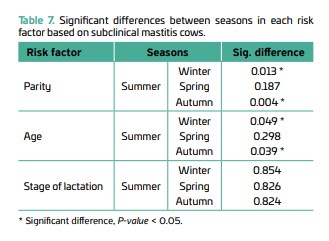Association of selected risk factors with bovine subclinical mastitis
DOI:
https://doi.org/10.21708/avb.2021.15.2.9785Abstract
A total of 695 Holstein Friesian lactating dairy cows were examined for the prevalence of subclinical mastitis (SCM) and its association with selected risk factors in a private dairy farm at Fayoum district, Egypt. 444 lactating cows with 1145 quarters were found positive for SCM with prevalence of 63.88% and 41.18% at cow and quarter level respectively based on California Mastitis Test (CMT), Electrical Conductivity (EC) that had a mean value of 6.27 ± 0.066 mS/cm and Somatic Cell Count (SCC) with a mean value of 8.8×105 ± 9.2×103 cells/ml. The risk factors investigated in this study revealed that the highest percentage of SCM was observed in winter, in cows at the late lactation stage with a percentage of 32.21 and 59.91 respectively. The results concluded that the young age cows were exposed to SCM more than old ones. While the occurrence of SCM was higher in cows with 2nd, 3rd and 1st than those with 4, 5, 6th parity number. The analytical results also revealed that there is a highly significant difference (p < 0.05) between numbers of parity. However, there is no significant difference (p > 0.05) between different stages of age, lactation and season as risk factors.
Downloads

Downloads
Published
Issue
Section
License
Autores que publicam na Acta Veterinaria Brasilica concordam com os seguintes termos: a) Autores mantém os direitos autorais e concedem à revista o direito de primeira publicação, com o trabalho simultaneamente licenciado sob a Licença Creative Commons Attribution que permite o compartilhamento do trabalho com reconhecimento da autoria e publicação inicial nesta revista. b) Autores têm autorização para assumir contratos adicionais separadamente, para distribuição não-exclusiva da versão do trabalho publicada nesta revista (ex.: publicar em repositório institucional ou como capítulo de livro), com reconhecimento de autoria e publicação inicial nesta revista. c) Autores têm permissão e são estimulados a publicar e distribuir seu trabalho online (ex.: em repositórios institucionais ou na sua página pessoal) a qualquer ponto antes ou durante o processo editorial, já que isso pode gerar alterações produtivas, bem como aumentar o impacto e a citação do trabalho publicado (Veja O Efeito do Acesso Livre).


 Esta obra está licenciada com uma Licença
Esta obra está licenciada com uma Licença 